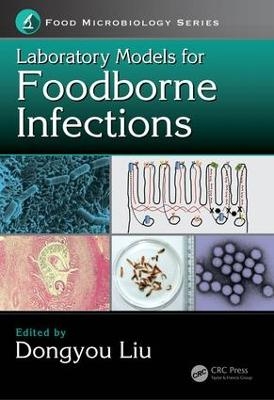
Laboratory Models for Foodborne Infections
Crc Press Inc (Verlag)
978-1-4987-2167-7 (ISBN)
Given the obvious benefits of laboratory models in foodborne disease research, a great number of experiments have been conducted toward the elucidation of host-pathogen interactions in and pathogenic mechanisms of foodborne infections. Forming part of the Food Microbiology series, Laboratory Models for Foodborne Infections presents a state-of-the-art review of laboratory models that have proven valuable in deciphering the life cycle, epidemiology, immunobiology, and other key aspects of foodborne pathogens.
Written by scientists with respective expertise in foodborne pathogen research, each chapter includes a contemporary summary of a particular foodborne viral, bacterial, fungal, or parasitic infection in relation to its life cycle, epidemiology, clinical features, pathogenesis, host-pathogen interactions, and other related aspects. Besides providing a trustworthy source of information for undergraduates and postgraduates in food microbiology, Laboratory Models for Foodborne Infections offers an invaluable guide for scientists and food microbiologists with interest in exploiting laboratory models for detailed study of foodborne infections.
Dongyou Liu, Ph.D., undertook veterinary science education at Hunan Agricultural University, China and postgraduate training at University of Melbourne, Australia. Over the past two decades, he has worked at several research and clinical laboratories in Australia and the United States of America, with focuses on molecular characterization and virulence determination of microbial pathogens such as ovine footrot bacterium (Dichelobacter nodosus), dermatophyte fungi (Trichophyton, Microsporum and Epidermophyton) and listeriae (Listeria spp.), as well as development of nucleic acid-based quality assurance models for security sensitive and emerging viral pathogens. He is the author of > 50 original research and review articles in various international journals, the contributor of 165 book chapters, and the editor of "Handbook of Listeria monocytogenes" (2008), "Handbook of Nucleic Acid Purification" (2009), "Molecular Detection of Foodborne Pathogens" (2009), "Molecular Detection of Human Viral Pathogens" (2010), "Molecular Detection of Human Bacterial Pathogens" (2011), "Molecular Detection of Human Fungal Pathogens" (2011), "Molecular Detection of Human Parasitic Pathogens" (2012), "Manual of Security Sensitive Microbes and Toxins" (2014), and "Molecular Detection of Animal Viral Pathogens" (2016), which are published by CRC Press. He is also a co-editor for "Molecular Medical Microbiology 2nd edition" (2014), which is released by Elsevier.
Introductory remarks. FOODBORNE INFECTIONS DUE TO VIRUSES. Adenovirus. Astrovirus. Hepatitis E Virus. Norovirus. Rotavirus. Prion. FOODBORNE INFECTIONS DUE TO GRAM-POSITIVE BACTERIA. Bacillus. Clostridium. Enterococcus. Listeria monocytogenes. Mycobacterium. Staphylococcus. Streptococcus. FOODBORNE INFECTIONS DUE TO GRAM-NEGATIVE BACTERIA. Aeromonas. Bacteroides. Brucella. Burkholderia. Campylobacter. Cronobacter: virulence and pathogenesis. Escherichia. Helicobacter. Klebsiella: Caenorhabditis elegans as a laboratory model for Klebsiella pneumoniae infection. Proteus. Pseudomonas. Salmonella. Shigella. Vibrio: Caenorhabditis elegans as a laboratory model for Vibrio infections. Yersinia. FOODBORNE INFECTIONS DUE TO FUNGI. Alternaria. Aspergillus. Candida. Enterocytozoon bieneusi. Fusarium. Penicillium and Talaromyces. FOODBORNE INFECTIONS DUE TO PROTOZOA. Acanthamoeba. Cryptosporidium. Cystoisospora belli. Entamoeba histolytica. Giardia lamblia. Toxoplasma: animal and in vitro models on toxoplasmosis. FOODBORNE INFECTIONS DUE TO HELMINTHS. Anisakis. Clonorchis sinensis. Fasciola and fasciolosis. Haplorchis. Metagonimus. Opisthorchis viverrini. Paragonimus. Taenia. Trichinella.
| Erscheinungsdatum | 07.06.2017 |
|---|---|
| Reihe/Serie | Food Microbiology |
| Zusatzinfo | 72 Tables, black and white; 38 Illustrations, color; 33 Illustrations, black and white |
| Verlagsort | Bosa Roca |
| Sprache | englisch |
| Maße | 178 x 254 mm |
| Gewicht | 2222 g |
| Themenwelt | Medizin / Pharmazie ► Allgemeines / Lexika |
| Studium ► 2. Studienabschnitt (Klinik) ► Pharmakologie / Toxikologie | |
| Studium ► Querschnittsbereiche ► Infektiologie / Immunologie | |
| Technik ► Lebensmitteltechnologie | |
| ISBN-10 | 1-4987-2167-2 / 1498721672 |
| ISBN-13 | 978-1-4987-2167-7 / 9781498721677 |
| Zustand | Neuware |
| Haben Sie eine Frage zum Produkt? |
aus dem Bereich


